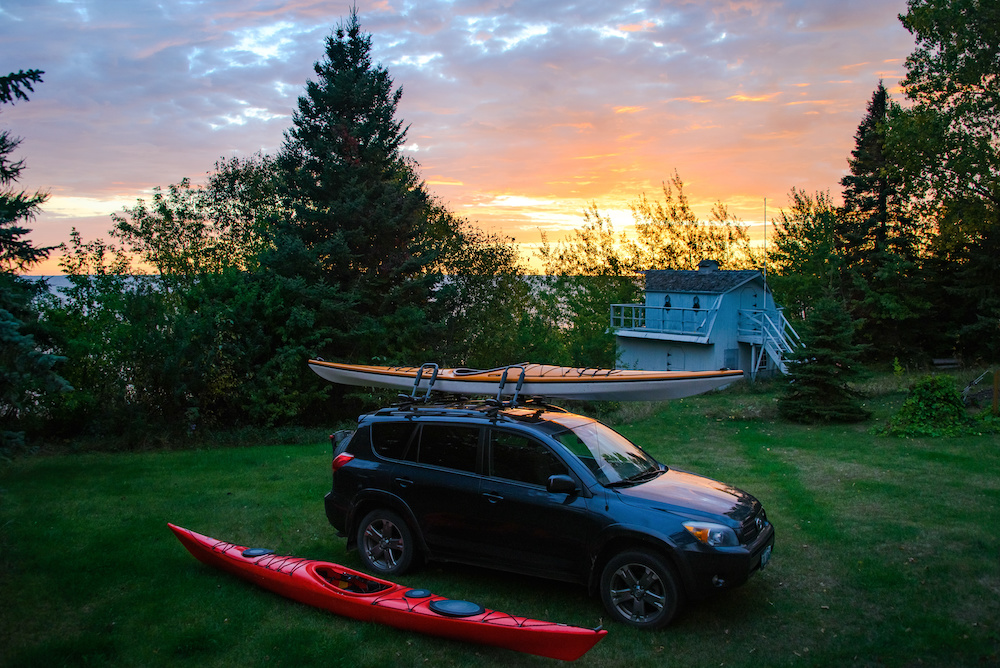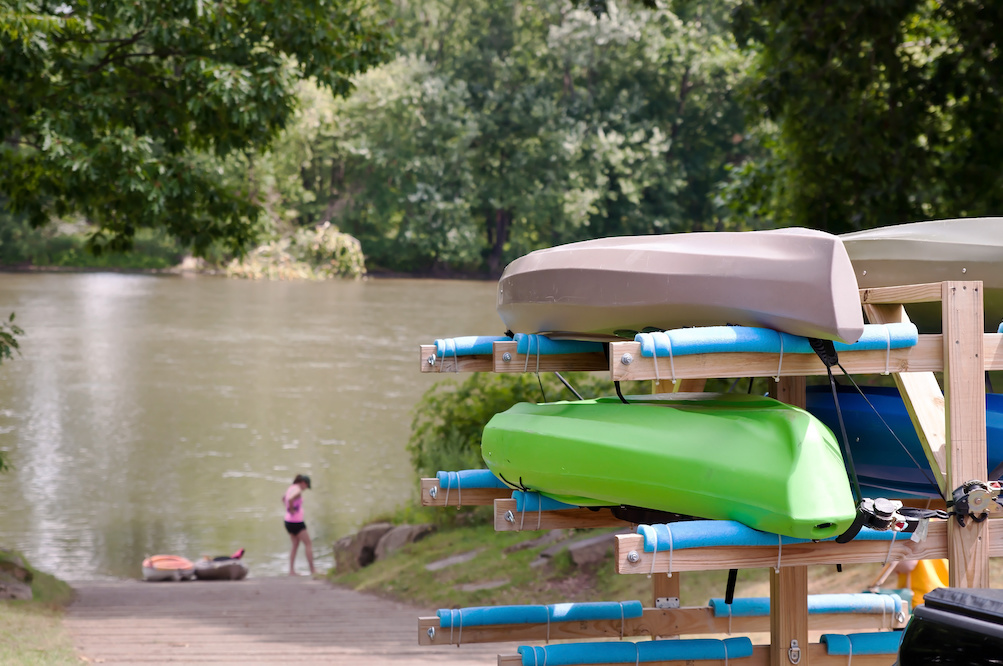How To Build a Kayak Rack?
We may earn a commission for purchases using our links. As an Amazon Associate, we earn from qualifying purchases.
Kayaks are big water vessels that can occupy more space than you could expect.
In that case, learning how to build a kayak rack is a valuable solution for storing your boat correctly.
Water enthusiasts are often too focused on the type of kayak they want to buy.
As such, they fail to think about how and where to store a kayak when not in use.
Storing them ensures that they will not be damaged and will last a long time for your family to enjoy.
Kayak Storage Basics
Most kayak owners invest in boats with durable materials and excellent build quality.
However, it’s not every day that they use these water vessels, so they need a proper storage place.
Even if you own the sturdiest kayak, improper storage can damage your boat over time.
As a responsible kayak owner, ensure that you know where to store it and how it is supported while not in use.
And that depends on what style you have.
Sit-on-Top Kayak
The best way to store a sit-on-top kayak is by putting its deck side down on padded flat bars.
You can also use two-by-fours or sawhorses, as long as they have paddings on them.
More importantly, you will want to make sure that the weight of the hull is evenly distributed on the supports.
And in case dents appear, you may need additional surface areas.
If you want to keep the kayak inside and protect it from the elements, store it on padded supports or straps with its deck side up.
When storing kayaks indoors, leaving the seat installed will provide lateral support for your boat.
Sit-on-top kayaks should never be hanging by their handles, as this position will damage the boat.
Sit-Inside Kayak
Dust, small critters, or water can fill the large cockpit of a sit-inside kayak when stored incorrectly.
If you have no intentions of using the kayak for a long time, make sure to install a cockpit cover before storing it.
Store the kayak on padded bars or straps with its deck side facing down.
You can also store this vessel in J-style cradles and on its side with sufficient paddings.
Indoor vs. Outdoor Kayak Storage
Kayak owners prefer indoor storage to protect their boats against natural elements, especially ice, rain, and sunlight.
Paddlers can store their kayaks with their decks’ sides up or down indoors without fear of the elements causing damage.
On the other hand, kayaks stored outdoors should only be placed deck-side down.
It is still possible for the kayak to accumulate moisture even if you cover it eave or tarp.
Unfortunately, moisture accumulation can freeze and expand the kayak and damage the hull.
How To Build a Kayak Rack?
Building this storage spot for your kayak typically requires few materials and can be done within a day or two.
You can choose to create a simple kayak rack in your garage or backyard or opt for a more complex style.
You will come across several options for building a kayak rack, but two of the most common materials are wood and PVC.
There are different methods for creating a kayak rack to keep it off the ground and protect it from bugs and outdoor elements.
It will also keep your backyard looking clean and organized at all times.
You may be overwhelmed and confused with the abundance of kayak rack DIY solutions you can find online.
To give you an idea of what and how to do it, we will show you different ways to build a kayak rack.
DIY Wooden Kayak Rack
The first project is this wooden kayak rack you can make in a day. You can use untreated materials and change them to your preferences.
Things You Will Need
- Chisel
- Circular saw
- Drill
- Hammer
- Miter Saw
- Screws
- Wood
- Wood Glue
How It’s Done
Here is the step-by-step guide to making a DIY wooden kayak rack.
Step 1: Make two similar posts.
Cut the wood based on your preferred length and make multiple cuts using the circular saw to create notches.
Make sure that you clean up the notches on the wood’s edges using the chisel and hammer.
These notches will hold the arms of your DIY kayak rack.
Step 2: Create the arms of the kayak rack.
You will need 12 pieces of wood for the arms of the kayak holder.
To start, use the miter saw to make diagonal cuts for aesthetics. You will also need six shorter wood pieces for the arms’ extra support.
All these wood cuttings can make a rack for two kayaks. You can also add extra arms if you need additional storage spaces for more kayaks.
Step 3: Assemble the DIY kayak rack parts.
Attach the wood arms on the notches you have made on the post, fixing two on the bottom, middle, and top.
Then, use wood glue to assemble all the wood pieces.
If you want to add support and ensure strength, drill holes and screw the parts together. Remember to leave a little space between each pair.
After that, insert the shorter wood pieces in between using glue before attaching one end to the post.
Step 4: Connect both posts.
After you attach the arms to each post, connect these two columns with three pieces of wood measuring two by four inches.
This connection will also serve as the back support of your DIY kaya rack.
Glue and screw these parts to the posts to ensure support and stability.
You can even make it multi-functional and use this to hang other kayaking essentials.
Step 5: Finishing the back part of the DIY kayak part.
Cut the other wood in a picket-like fence design using the miter saw, making sure that it fits the back part of your kayak rack.
Step 6: Add foams to the arms.
To ensure that there will be no dents on your kayak, don’t forget to add foam padding on the arms.

DIY PVC Kayak Rack
Another easy and affordable material option you can try is PVC.
Let’s see what the things you will need are and how to create the kayak rack.
Things You Will Need
- 1 ¼ schedule 40 PVC pipes cut into the following measurements:
- Two pieces of 24 inches
- Two pieces of 10 inches
- Four pieces of 30 inches
- Two pieces of five inches
- Two pieces of 18 inches
- Two pieces of five-foot pipes
- Six tee PVC pipes
- Two elbows
- Four PVC caps
How It’s Done
Follow the step-by-step instructions below to build your DIY PVC kayak rack.
Step 1: Create the first post.
Connect a 24-inch pipe to one end of a tee. Then, attach one of the 10-inch pipes on the tail end before linking another tee.
If your first tee’s open end points upwards, ensure that the second tee is directed sideways.
Next, add one of the five-inch pipes to the second tee, followed by the third in a similar direction as the first tee.
Now, link one end of an 18-inch pipe to the third tee. Connect an elbow to the other end, ensuring that it’s facing the same direction as the second tee.
Step 2: Create the second post.
Following the same procedure as the first post, create another post for the other side of the kayak rack.
In contrast to the first post, the tees and elbows on the second must face the opposite way.
Step 3: Connect the other pipes and tees.
For the kayak rack’s arms, connect the 30-inch pipes to each of the four tees facing the same direction.
Then, cover all the 30-inch pipes with PVC caps.
Step 4: Connect the two posts.
After making the posts, the last step is to connect and assemble everything.
You need to attach the five-foot pipes to the remaining elbows and tees for the back part of your DIY PVC kayak rack.
Once everything is put together, finish it up with a spray paint color of your liking.
Lastly, wait until the paint is dry before putting your kayak.
How To Build a Kayak Rack for Truck
Pick-up trucks are usually the vehicle of choice for excursions and adventures.
However, it is still a challenge to fit a kayak in the truck bed.
Tying knots on your boat at the back of your truck is not enough and can damage the kayak due to constant bouncing and bending during transport.
As such, it would be best to build a DIY kayak rack to transport your boat safely and securely.
Design a kayak rack for your truck after taking measurements.
Use pressure-treated two-by-fours as your primary material and connect them using screws.
Your main goal is to create two crossbeams wider than the truck bed and a little higher than the roof.
You will need four uprights for each corner of your truck bed.
Depending on your preference, you can choose to attach them permanently or create a separate frame for portability.
The next step is to create stabilizers. Crossbeams and uprights will not be enough to support and secure your kayak while in transit.
Once you have made these three major parts, you can easily make adjustments as needed.
Conclusion
As you can see, building a kayak rack is relatively easy with all the available resources online.
All you need to prepare is the required materials.
Most of these DIY kayak rack plans are easy to follow and will only need a day or two of your attention.
Ask any paddler, and you’ll know that it is better to protect your precious kayak by storing them in suitable racks.



